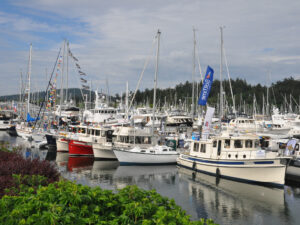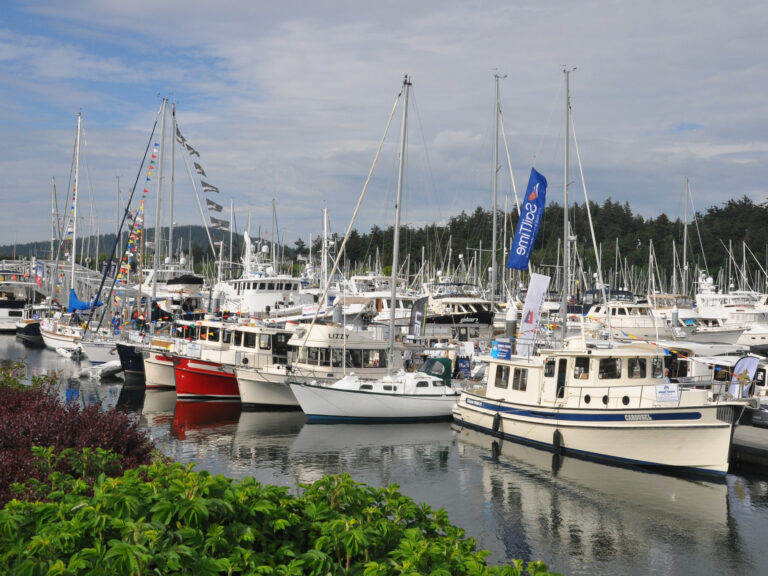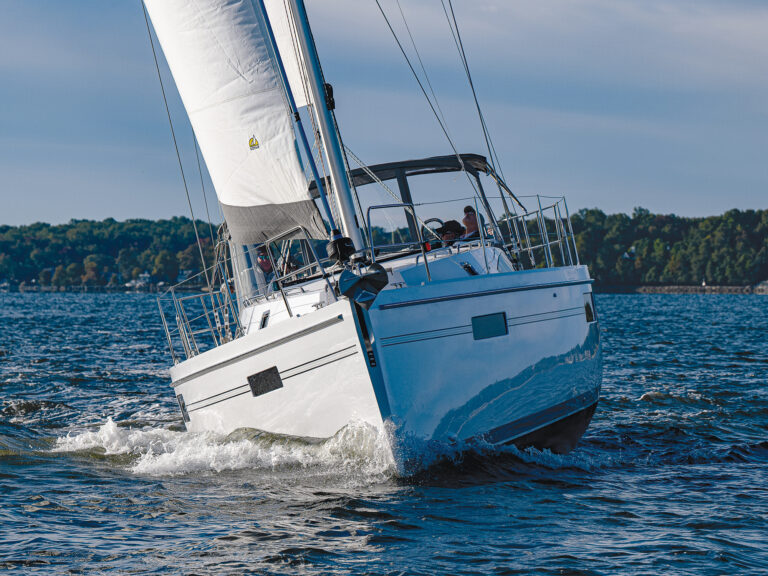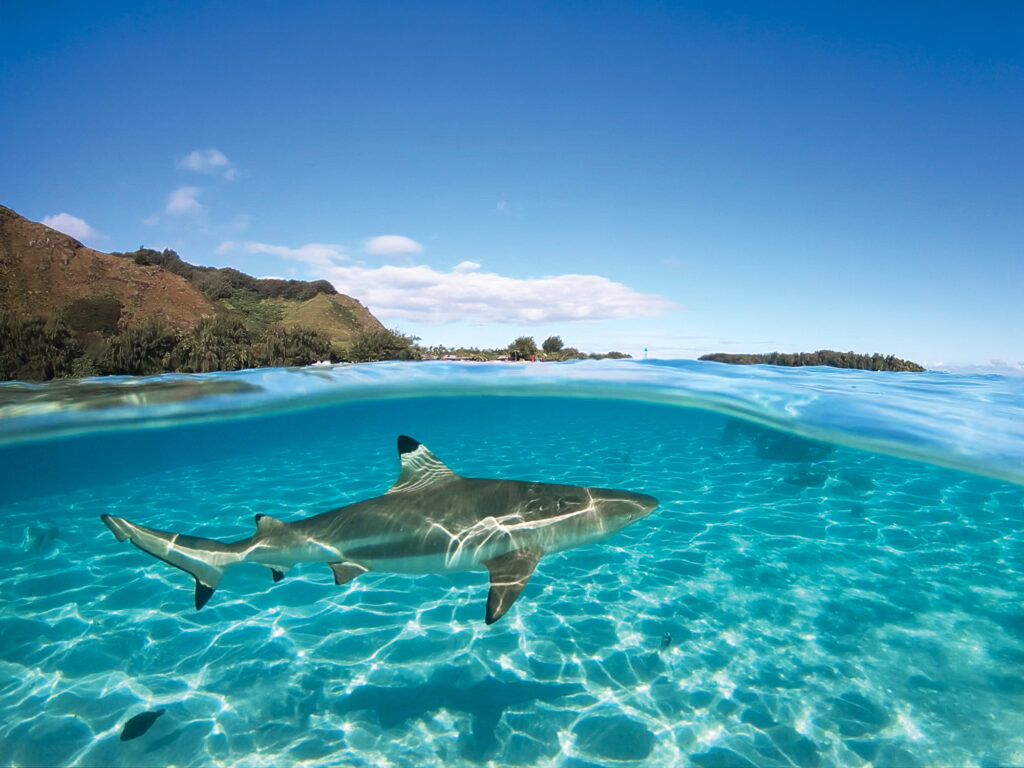
The outgoing tide shot us through the narrow pass at 10 knots, spitting our C&C 43 into the beatific blue of the South Pacific. We’d just spent a few days anchored inside the tiny atoll of Kauehi, 100 miles northeast of Tahiti in French Polynesia’s Tuamotus archipelago, to recover from a five-day passage from the Marquesas Islands. We were heading to a bigger atoll to replenish provisions.
But first, my husband, Rob, and I had a request of our captain: Let us jump overboard.
He thought we were nuts. There were no boats in sight. No people for miles. Just the endless expanse of the Pacific ahead and 3,000 feet of water under our keel.
Plus, one of the biggest feeding frenzies on Earth was about to begin.
Hundreds of sharks congregate each June in the Tuamotus’ passes to prey on the thousands of grouper that arrive to spawn on the reefs. Under a full moon near the winter solstice, these coral-dwelling fish release a terrific cloud of sperm and eggs in unison. The sharks swoop in to pick off the distracted grouper.

Rob wanted to witness the frenzy. He loved sharks, along with wild places full of animals wilder than himself. I, on the other hand, was terrified of sharing space with sharp-toothed predators.
Every sailor I know has one fear that outweighs all the others (because, let’s be honest, there are plenty of rational fears that go hand in hand with setting out across large oceans on small boats). One friend is petrified of running aground. Another refuses to anchor anywhere that sea snakes slither. One loses sleep over how to handle storms at sea.
When we set out to cross the Pacific, I wasn’t really worried about rogue waves or lightning. I wasn’t overly concerned about doldrums or underwater reefs. But my stomach twisted into gnarly knots when I thought about seeing a shark while snorkeling.
Let me back up: Crossing the ocean had been my idea. It took root when I was a little girl listening to my dad tell stories about delivering a yacht from Hawaii to California. He told me about pilot whales that nearly rammed the boat. About swinging out over the sea with a line tangled around his ankle, a gust shaking him like a rag doll over the deck. About diving deep beneath Maui’s waves to retrieve a silver pendant to gift my mom. About the endless hours on night watch, searching for mermaids and spaceships. About the blues and greens, too many to name, too vivid for words.
There were no boats in sight. No people for miles. Just the endless expanse of the Pacific ahead and 3,000 feet of water under our keel.
I wanted to see all those colors too. So in 2013, Rob and I quit our jobs, rented out our house, sold most of our belongings, and hitchhiked west as volunteer crew. We considered buying our own boat to cruise the South Pacific but ran up against two cold hard facts: Boats are expensive, and neither of us had sailed overnight, much less had enough experience to cross the largest ocean on Earth.
What we did have going for us was flexibility, a high risk tolerance, an appetite for adrenaline, and a willingness to hang out in small spaces with strangers for days on end. So we stuck out our thumbs (figuratively, at least) by posting a “crew available” ad in an online forum.

By the time we reached the Tuamotus, we were crewing on our second boat, Kyanos, captained by Ben, a 26-year-old from Alaska. Although we’d been sailing and snorkeling for nearly four months by this point, I’d so far managed to avoid swimming next to any sharks.
And maybe I could’ve kept it that way. But the one thing I hate more than being scared is missing out on cool stuff. Plus, I knew that the best way for me to overcome my fears was to face them head-on.
So, I decided to jump overboard into the deep with Rob, feeding frenzy and all.
Ben agreed to sail a loop while we snorkeled, confident that he could pick up two tiny specks in an enormous sea. We were all young enough not to second-guess stupid decisions.
I stripped down to my bathing suit and then clambered to the rail, mask in hand, to put on my fins.
“On the count of three?” Rob asked. I nodded, and we catapulted overboard. Warm water closed overhead. It swallowed all sound. When I broke through the surface, Kyanos was already a dot in the distance.
Panic rose like bile. In theory, I knew that Ben would come back for us. But my body revolted at the reality of being completely on our own.
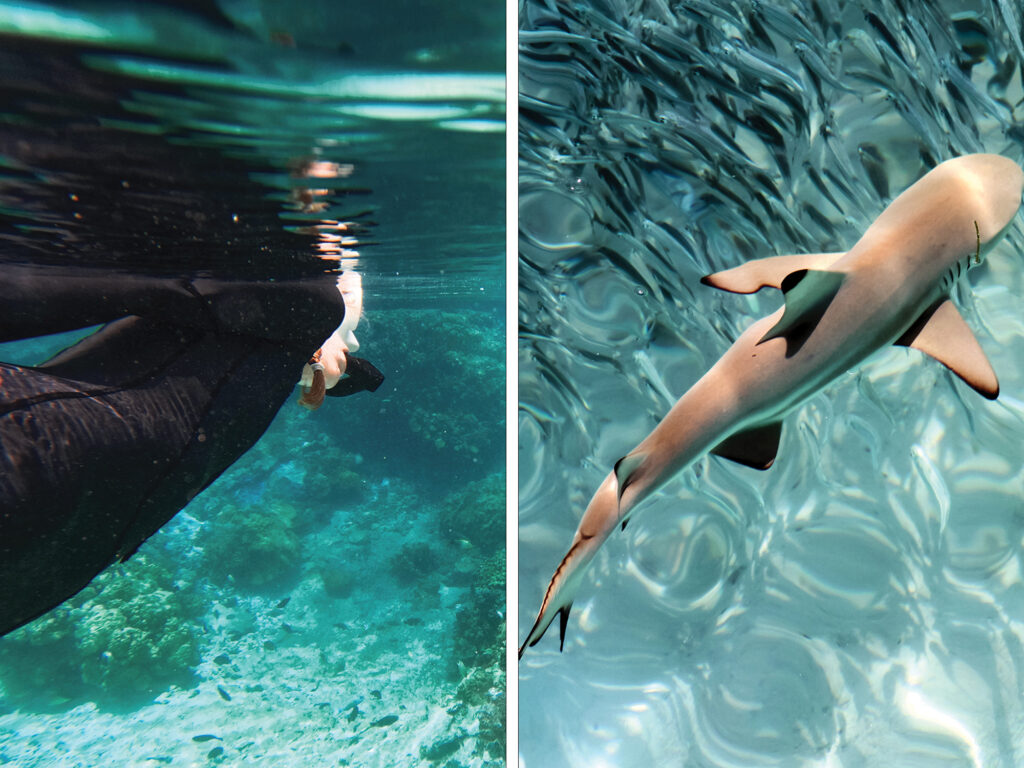
I looked to my right and saw Rob flash a thumbs-up before duck-diving. Treading water, I struggled to secure my mask. The water was so clear, I could see the green polish on my toenails. Sunbeams slanted into the abyss, stirring up a nervous weightlessness in my belly. It would be less scary once I could actually see what was swimming around me, I told myself. At least in theory.
But then Rob reappeared, yelling: “Hurry! There’s a shark right here!”
He meant “hurry” so that I didn’t miss seeing the shark, not hurry to get away from it. Not that there was a safe place to swim to. I girded my wits, held my breath, and looked underwater.
I saw not one shark but a dozen, all swimming steadily toward us. Nothing like trial by fire.
I floundered backward with a garbled shriek. My heart jackhammered against my ribs as I kicked frantically away from the menacing snouts. Rob’s hand encircled my arm and he put his face an inch from mine, looking into my eyes. He made the diving signal for OK, then started leisurely swimming toward the narrow strip of Kauehi’s coral 100 yards away.
His lack of concern about our impending evisceration calmed me slightly. But I kept looking over my shoulder as we kicked toward the reef, my breath sounding like Darth Vader through my snorkel. Our entourage of reef sharks followed, a few of them longer than me. They cruised a couple of body lengths behind us, as if they were curious why we were in the middle of the deep blue sea. I was wondering that myself.
Abruptly, the bottom came into view, sloping sharply upward. I immediately felt safer. Sure, sharks could just as easily eat us in 20 feet of water as they could in 2,000 feet. But seeing shore—even a barely there, sharp-as-hell shore—gave me back a sense of control.
Panic rose like bile. I knew that Ben would come back for us. But my body revolted at the reality of being completely on our own.
My dread dwindled further as the sharks dispersed, suddenly more interested in the fish swarming along the reef. I was too. It was the most vibrant, colorful scene I’d ever seen. Fish that embodied their names: snapper, parrot, butterfly, trigger, squirrel, unicorn. Over here was a courtship display, there a fight. Drama, tragedy and comedy all played out in Technicolor as I watched, fear forgotten.
Until something bumped my shoulder.
I spun around, adrenaline spiking sky-high in a nanosecond. But it was just a tattoo-faced Maori wrasse, as big as a Labrador and about as friendly. Rob appeared in my periphery, gesturing me to follow him around the corner. He pointed out a patch of reef where the grouper were so dense, it looked like a carpet of fish laid over the coral. I watched him dive down to prod a female, her belly swollen with eggs.
Then Rob pointed out into the deep water from which we’d swam. I followed his gaze.
And saw hundreds of sharks.
They were hovering about 30 feet below the surface, a line of ominous gray shapes stacked on top of one another as far as I could see.
My muscles wound tight again, ancient instincts telling me to flee. But, somehow, I held still. Breathed my slow, Darth Vader breaths. Told myself that humans weren’t on their menu, not with their bellies full of grouper.
I relaxed in micro-increments, keeping tight to the shallows. Their tails moved in slow arcs as they hovered in place. I grew mesmerized by the slow flare of their gills. It was so graceful. Peaceful, even.
Rob broke my trance, motioning me to the surface. Disoriented by the bright sun, I spit out my snorkel. The wind felt loud and chaotic, as foreign as the water had felt a half-hour before.
“Current’s picking up,” Rob yelled. “We should swim back out to meet Ben.”
He was right. While I’d been making peace with sharks, the tide had changed. We were starting to get sucked back toward the pass.
I kicked hard, trying to make progress against the current. Panic rose again. What if we couldn’t make it back to Kyanos? Maybe we should’ve made a better plan than “come get us eventually.”
Our boat was still a dot in the distance. I waved my arms overhead, then gave up as I lost ground. I stroked fast again to catch up with Rob, air whooshing in and out of my snorkel. My lungs burned. My legs started to cramp.
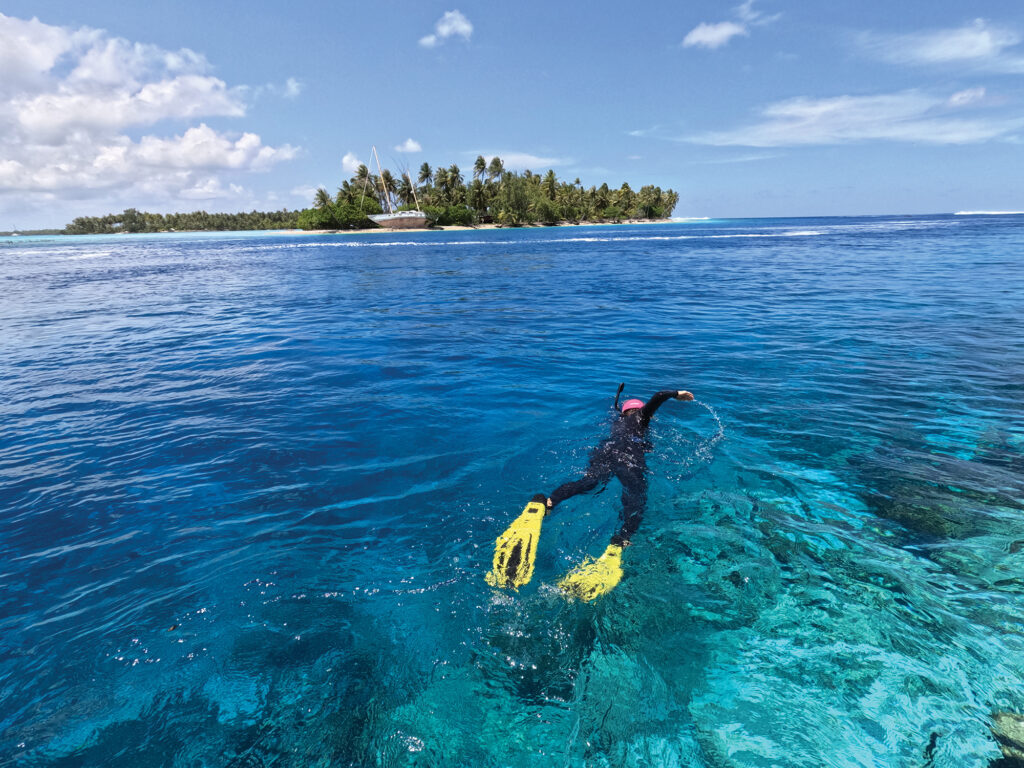
The next time I chanced a look, relief flooded through me. Kyanos was close. This time, we both waved our arms, and Ben saw us, tacking to adjust course.
Relief was short-lived: Kyanos was trucking through the waves at 8 knots, proving her racing chops. Now I was terrified that we might get run over.
But Ben hove-to expertly a few dozen yards away from us. He threw out a coil of floating yellow line, which jerked taut in the boat’s wake. I latched on, and then promptly began plowing through the water face-first. Even hove-to, Kyanos was still moving faster than I’d anticipated. My bathing-suit bottoms sluiced down around my ankles as I held on for dear life.
“Pull yourself up the line, Bri! Hand over hand!” Rob yelled, holding on behind me.
It was slow going, but I eventually made it back to the boat. I grabbed a stanchion and heaved while Rob shoved my bare butt up from below. I collapsed in the cockpit.
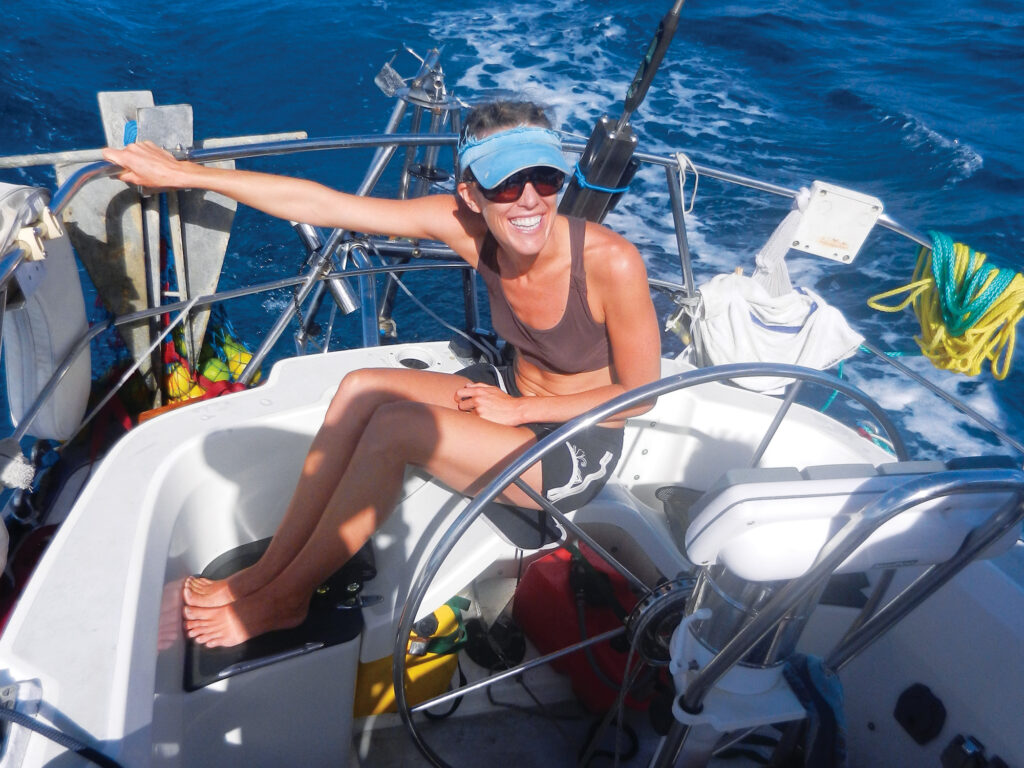
“Good time?” Ben asked, averting his gaze as he passed me a towel.
“So good,” Rob exclaimed, tossing my wet shorts into the cockpit. “God, I love sharks.”
Flying high on endorphins now that I was finally safe from a near-death experience, I laughed. “You know,” I said, “I just might love them too.”


